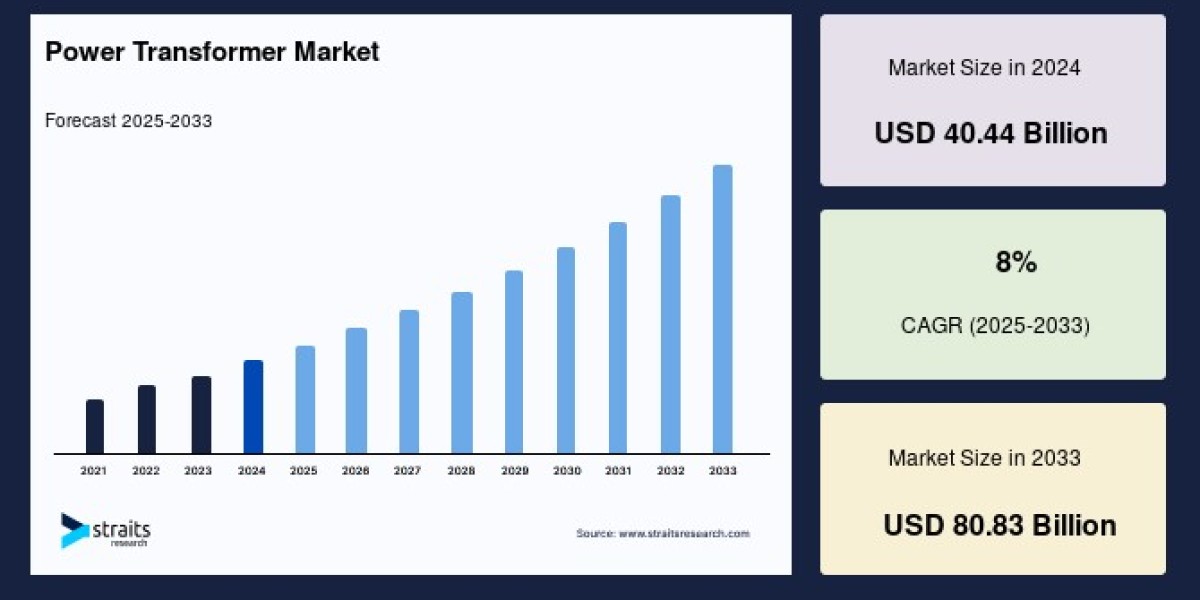Introduction
The global power transformer market size was valued at USD 40.44 billion in 2024 and is expected to reach from USD 43.67 billion in 2025 to USD 80.83 billion by 2033, growing at a CAGR of 8.0% during the forecast period (2025–2033).
Market Overview
Power transformers play a crucial role in converting low-voltage generator electricity to high voltage for long-distance transmission, minimizing power losses and enhancing grid stability. These transformers operate with high efficiency at full or peak load, a key factor as transmission voltages continue rising globally, including ultra-high voltage (UHV) transmission systems exceeding 1100 kV.
The necessity to upgrade outdated infrastructure, coupled with rapid industrialization and urbanization, propels demand worldwide. The expanding electric vehicle sector also contributes significantly to increased power consumption and transformer requirements.
Growth Drivers and Market Dynamics
Several factors underpin the power transformer market’s growth trajectory:
Rising Electricity Demand
Global demand for electricity is steadily increasing due to population growth, expanding industries, urbanization, and improved electrification in emerging markets. This increase necessitates enhanced transmission and distribution capabilities, driving investment in power transformers.Integration of Renewable Energy
The rise of renewables such as wind, solar, hydroelectric, geothermal, and biomass energy places transformer technology at the forefront. Transformers facilitate the seamless integration of variable renewable power into the grid by stepping up generation voltage and enabling transmission to substations or end-users.Smart Grid and Advanced Technologies
Smart grids and related advanced technologies demand transformers capable of supporting digital monitoring, remote control, and energy management to augment grid reliability and efficiency. These technological advancements also emphasize eco-friendly and energy-efficient transformer designs.Infrastructure Modernization and Replacement
A significant portion of the existing power transformer infrastructure is aging and subject to replacement. Moreover, investments in upgrading transmission networks, especially to higher voltage levels such as UHV, necessitate the adoption of modern power transformers to reduce losses and enhance system performance.
Market Segmentation
The power transformer market is segmented primarily by transformer rating and application:
Medium-rating power transformers (100 MVA to 500 MVA) dominate the market share. These transformers are instrumental in transmission substations and industrial power distribution, benefiting from the upgrade to higher voltage transmission lines to reduce power losses.
Low-rating transformers (under 100 MVA) serve generation step-up units, industrial plants, and various infrastructure applications.
High-rating transformers (801 MVA to 1200 MVA) are tailored for UHV transmission projects that enable long-distance power transfer with low losses and environmental impact.
Regional Insights
Asia-Pacific reigns as the largest market and fastest-growing region for power transformers, holding the highest market share while expected to grow at a CAGR of approximately 9.1%. Nations like China, India, Australia, and Indonesia drive this growth due to aggressive investments in grid modernization, renewable energy integration, and industrial expansion. China’s leadership in UHV DC/AC transmission systems and India’s growing demand for upgraded power networks underscore the region’s pivotal role.
North America, although smaller in market size compared to Asia-Pacific, is also a fast-growing market with a CAGR around 7.4%. The region benefits from established infrastructure, advanced technologies, and increasing renewable energy projects like offshore wind and utility-scale solar. Government incentives and infrastructure upgrade programs continue to push market expansion.
Europe shows moderate growth with a focus on replacing coal-based energy sources with nuclear and renewables, necessitating modern transformers to ensure grid stability and integration of renewable capacities.
LAMEA (Latin America, Middle East, and Africa) exhibits potential for growth driven by industrial development and increasing electricity consumption, with significant investments anticipated to improve power infrastructure, particularly in Africa.
Challenges and Restraints
Despite positive growth factors, certain challenges persist:
High Costs: Manufacturing, logistics, installation, and supporting infrastructure costs for power transformers are substantial, potentially restraining market entry for smaller players and slowing adoption.
Raw Material Price Volatility: Transformers rely heavily on copper, steel, and aluminum, whose price fluctuations impact production costs and market pricing.
Long Production Lead Times: Manufacturing and delivery of power transformers require considerable time, complicating the rapid scaling of infrastructure.
Opportunities
The rising focus on clean energy and smart infrastructure opens various long-term opportunities:
Development of eco-friendly transformers with advanced insulation and energy efficiency.
Expansion of UHV transmission lines enabling large-scale renewable energy transmission over long distances.
Deployment of power transformers in emerging renewable energy plants such as tidal and geothermal located near generation points.
Increasing adoption of digital monitoring and AI-enabled grid management enhances transformer functionalities.
Conclusion
The global power transformer market is poised for strong growth over the coming decade, driven by the surging need for reliable, efficient electricity transmission to support industrial, residential, and renewable energy demands. Asia-Pacific leads in market size and growth pace, followed by robust expansions in North America and promising developments in Europe and LAMEA regions. Despite challenges like cost and manufacturing complexities, technological innovation and infrastructure investments provide ample growth avenues, making power transformers an indispensable component of the evolving global electricity landscape.













